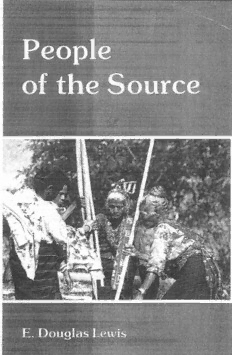
People of the Source: The Social and Ceremonial Order of Tana Wai Brama on Flores PDF
Preview People of the Source: The Social and Ceremonial Order of Tana Wai Brama on Flores
PEOPLE OF THE SOURCE SUB Góttingen 107609 398 Mo’an Robertus Rapa Ipir Wai Brama Source of the Domain ofTana Wai Brama, 1979 Cover: Led by Du’a Rudun Ipir Wai Brama, the headwoman of the source dan of the domain, clan headwomen of Tana Wai Brama dance ar ound a rice anortar in preparation for the gren mahé rituals. The women are wearing corded patota cloths, part of the ceremonial wealth of their clans. Kloang Watuwolon, October 1980. V E R H A N D E L I N G E N VAN HET KONINKLUK INSTITUUT VOOR TAAL-, LAND- EN VOLKENKUNDE 135 E. DOUGLAS LEWIS PEOPLE OF THE SOURCE THE SOCIAL AND CEREMONIAL ORDER OF TANA WAI BRAMA ON FLORES 1988 FORIS PUBLICATIONS Dordrecht-Holland / Providence-U.S. A. CONTENTS Foreword by James J. Fox xi Preface xv A note on language and orthography xix I Introduction 1 Prefatory remarks 1 2 Flores and Nasa Tenggara Timur 6 3 SiKka and Tana 'Ai 9 I II Tana: the land and the ceremonial domains of Tana 'Ai 1 Introduction 21 2 Topography, physieal features, and climate of the Tana 'Ai valley 21 3 The classifícations of the land 23 4 The garden cycle 26 5 Tana: the ceremonial domains of Tana 'Ai 32 6 Tana Wai Brama 37 III The origins of the world of the Ata Tana 'Ai 1 Introduction 45 2 The myths of creation and separation 45 3 The Myth of the Founding of the Domain 50 4 The origin of clan Ipir Wai Brama 52 5 Clan Ipir and the subaltern clans of Tana Wai Brama 61 IV The Source of the Domain 1 Introduction 71 2 Metaphors of the pregnant boundary 73 3 The Source of the Domain 76 4 Oda and hura: sequence and pattern in the ceremonial order of the domain 80 V The rituals of the domain and the ceremonial order of Tana Wai Brama 1 Introduction 89 2 The rituals of the seasons 93 VI Contení s 3 The gren: celeforations of the domain 95 4 The wu'a mahé 101 VI Clanship in Tana Wai Brama 1 Introduction 109 2 The clan (sukun) 111 3 Food taboos 114 4 The p ai ring of clans in ritual language 115 5 The pairing of clans in mortuary Service 119 6 Clan branches. 122 7 Secular and ritual authority within the clan 126 8 Dividing the basket: sopé and wélut as idioms of clanship 137 VII House and garden 1 Introduction 141 2 Household composition and residence patterns 144 3 The house as a physical and social entity 153 4 The ritual and syinbolie order of the garden 163 VIII Houses and the ritmáis of the domain 1 Introduction 171 2 The ritual houses of the gren mahé 172 3 Preparations for the gren mahé of 1980 175 4 Sequence in the organization of gren mahé 179 IX The ideology and idüom of blood 1 Introduction 187 2 The calculus of blood 188 3 Lu'ur-dolor relatíanships and the calculus of blood Í91 4 The cías sificatión of kin 195 X Marriage and the economy of blood 1 Introduction 203 2 Marriage and the exchange of father's forelock 205 3 Muía puda: the refurn of the "planted mother" 214 4 The language of Tana 'Ai alliance 218 XI Marriage, alliance, and the precedence of houses within clans 1 Introduction 223 2 Marriage and alliance 224 3 Oda: the ordering of houses within clans 227 XII The ceremonial expression of alliance 1 Introduction 249 2 Apu tudi nadar manu: the child exchange ceremony 249 3 Wawi arun: the gií't of the pig's jaw 252 Contení s vii XIII The life eyele of the spirit 1 Introduction 257 2 The life eyele and the soui 258 3 Death and the soul 262 4 Spirits 270 5 The social organization of the death eyele rituals 274 XIV Coneluding essay: metaphors of life and social reproduction 297 Appendix A. Common eultigens of Watuwolon 311 Appendix B. The languages of orientation and time 312 Notes 317 Bibliography 347 Glossary of words and phrases in Sara Tana 'Ai and Sara SiKka 351 Index 357 ILLUSTRATIONS Maps I The Eastern Lesser Sunda Islands 8 II Kabupaten Sikka 12 III The Tana 'Ai región oí eastern Flores 34 IV Site of the mahé of Tana Wai Bama 106 V The Hila-Watnwolon región of Tana Wai Brama 142 VI Kloang Watuwolon and environs 146 Tables 1 Pairing of the clans ín ritual language 118 2 Clans and clan branches of Tana Wai Brama 124 3 Distribution of ritual and secular authority in seveaa houses of clan Ipir Wai Brama 136 4 Principal lepo of the gren mahé of Tana Wai Brama 180 5 Summary of genealogies from Watuwolon 227 6 Clan endogamy, exogamy , and marriages of women as ama 'lo'en and muía puda 228 7 Affinal relations between houses in the Watuwolon are a 242 8 Completed minimal alliance cycles among houses of the Watuwolon región 246 Figures 1 Agrieultural and annual ceremonial cycle 23 2 Journeys of Hading Dai Dor and Uher la'i Atan 62 3 Morphology of the bambeo 75 4 Sequence and simultaneity in the narration of history 83 5 Metaphorical and metonymical relations of ritual speech 85 6 Delegation and diffusion of ritual authority in the gren mahé 97 7 Hiti karé Service 121 8 Lepo, du'a luka, and ritual specialists of clan Ipir Wai Brama 134
